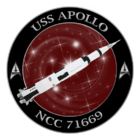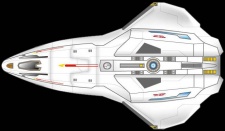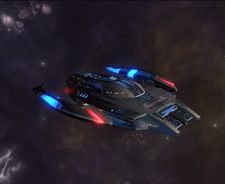Type-9
The Type-9 Personnel Shuttle is a long-range craft capable of traveling at high warp for extended periods of time due to new advances in variable geometry warp physics. Making its debut just before the launch of the Intrepid-class, this shuttle type is ideal for scouting and recon missions, but is well suited to perform many multi-mission tasks.
| Specification
|
Image
|
- Crew: 2, and 2 passengers
- Length: 8.50m
- Beam: 4.61m
- Height: 2.67m
- Decks: 1
- Armaments: 2 Type VI Phaser Emitters
- Deflectors: 4 symmetrical subspace graviton field grids
- Hull: Single light Duranium/Tritanium
- Warp Speeds: Cruising 4, Maximum 6 (sustainable for 6 hours)
- Quantity: 3; the Cernan, the Haise, and the Schirra
|
|
Type XI-S
The Type XI-S shuttlecraft is an advanced piece of technology, containing bioneural circuitry as a standard, as well as a compact power plant that still provides excellent cruising and maximum speeds. The cockpit is an individual compartment, separate from the rest of the shuttle, which a break from Starfleet's standard shuttle design.
| Specification
|
Image
|
- Crew: 2, plus 10 passengers
- Length: 14.64m
- Beam: 5.26m
- Height: 5.25m
- Decks: 1
- Armaments: 4 Type V phaser banks, 1 Micro-photon torpedo tubes with 20 torpedoes
- Deflectors: 8 symmetrical subspace graviton field grids
- Hull: Single light Duranium/Tritanium
- Warp Speeds: Cruising 4, Maximum 7 (sustainable for 3 hours)
- Quantity: 3; the Lovel, the Swigert, and the Collins
|
|
Arrow Class
Arrow Class Runabouts utilize the same "modular" construction in regard to interior makeup. They are compatible with standard Starfleet multi-use compartment modules and are much easier than even the conventional Runabouts being that the warp engines and wings feature a "gull" design which swing open for easy access to the interior. The compartment modules fit neatly inside and lock into place for optimum refit capability. The Arrow class is slightly longer than the standard Danube. This affords a somewhat roomier cockpit area, more work stations, and a larger crew complement.
| Specification
|
Image
|
- Crew: 4, plus 12 passengers
- Length: 26m
- Beam: 16.1m (Including wingspan)
- Height: 5.4m
- Decks: 1
- Armaments: 2 Type IX phaser banks, 1 Micro-quantam torpedo tube with 40 torpedoes
- Deflectors: 8 symmetrical subspace graviton field grids
- Hull: Single light Duranium/Tritanium
- Warp Speeds: Cruising 6, Maximum 8 (sustainable for 8 hours)
- Quantity: 3; the Grissom, the Glenn, and the Mitchell
|
|
Argo Class
The Argo Class Shuttle is one of the newest class of shuttle in the Federation. The Argo was designed with recessed warp nacelles and fold-down wings. These wings were designed to assist in atmospheric maneuverability. The shuttle was equipped with an all-terrain buggy that could transport up to three passengers over rugged terrain. The buggy was secured aboard the shuttle's cargo hold via wheel clamps. The shuttlecraft could also be remote controlled from a device on the buggy.
| Specification
|
Image
|
- Crew: 4
- Length: 14.50m
- Beam: 8.80(including wingspan)
- Height: 6.10m
- Decks: 1
- Armaments: 2 Type VI phaser banks, 1 Micro-photon torpedo tubes with 20 torpedoes
- Deflectors: 6 symmetrical subspace graviton field grids
- Hull: Single light Duranium/Tritanium
- Warp Speeds: Cruising 5, Maximum 7.5 (sustainable for 6 hours)
- Quantity: 2; the Armstrong, and the Aldrin
|
|
Aquarius class
The Aquarius-class starship was a Federation light escort designed as an auxiliary craft of the Odyssey-class. As development progressed on the new Odyssey-class starships, Starfleet Command saw the need for variants of the class in order to fill the various roles fulfilled by Starfleet vessels. As such, the aft section of the Odyssey variants was converted into docking ports for Aquarius-class light escorts.
Other systems incorporated into the Aquarius are 'sliding' pylons for the nacelles first designed for the Diligent class to allow it to dock within the aft bay of an Odyssey class ship...and for storage purposes when not in use. A Bio-Neural Processing Core allows for faster processing of data, especially for tactical systems. The small bridge-like cockpit area has seats for the commanding officer, tactical officer, pilot, and operations officer while a small engineering bay is on Deck 3 and is manned by two officers and four crewmembers.
A small Medical Bay is on Deck 3 while storage and a small Cargo Bay is on Deck 4. A small crew's mess, bunk-style berthing area, Heads, and a small Captain's Quarters with an Office are on Deck 2. The Aquarius class is also capable of atmospheric flight and is equipped with landing struts.
| Specification
|
Image
|
- Crew: 26, plus 10 passengers
- Length: 97m
- Beam: 64 meters (docked), 74.5 (in flight)
- Height: 38.1 meters
- Decks: 5
- Armaments:
- Phasers: 2 type-U (forward), 4 type-X
- Torpedoes: launchers: 4 (2 forward, 2 aft)
- Navigational Deflector: Molybdenum & Duranium Mesh
- Hull: Type-1 Ablative Armor
- Warp Speeds: Cruising 6, Maximum 9.85 (sustainable for 8 hours)
More Information on the Apollo-A's Aquarius class Artemis
|
|
The Core Management Unit, colloquially known as the "Work Bee" due to it's signature yellow hull, is a common site anywhere in the Federation. Unlike the Sphinx workpod, the Work Bee can only carry one passenger, who is usually fitted with a space-suit. As the CMU is primarily a maintenance craft, it can be equipped with a variety of tools, including a set of dual remote manipulator arms called the Grabber Sled. The CMU can also serve as a tug for cargo modules with the Cargo-Train Attachment. The CMU can operate both in the vacuum of space and within the atmospheric and gravitational conditions of a starship cargo bay or planetary surface.
| Specification
|
Image
|
- Crew: 1
- Length: 6.2m
- Beam: 2.6m
- Height: 2.5m
- Decks: 1
- Armaments: None
- Hull: Single light Duranium/Tritanium
- Warp Speeds: None
- Quantity: 40
|
|














